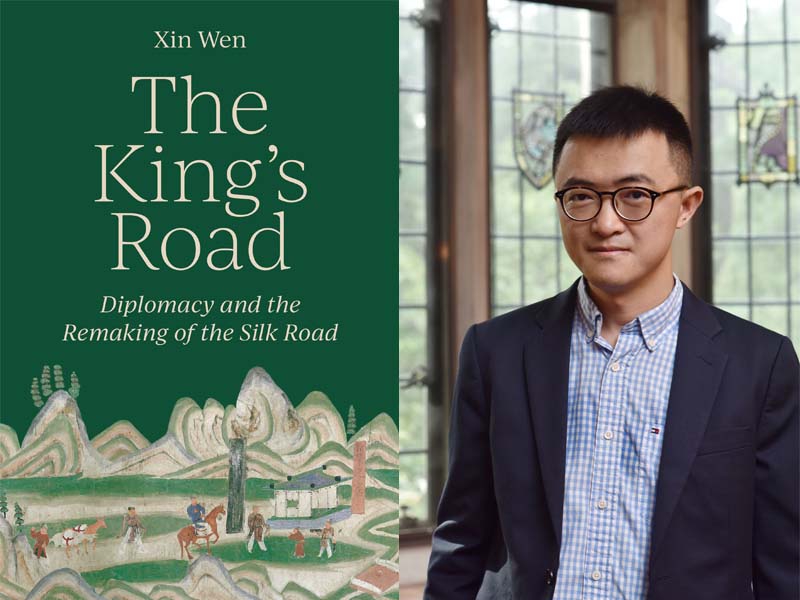Xin Wen is Assistant Professor of East Asian Studies and History and Johanna and Alfred Hurley ’61 University Preceptor. His book “The King’s Road: Diplomacy and the Remaking of the Silk Road” was published January 2023 by Princeton University Press.
How did you get the idea for this project?
This project began about ten years ago as my dissertation in Inner Asian and Altaic Studies at Harvard University, which I defended in 2017. I had two reasons to choose this topic. The broader reason was that I had always been interested in the Silk Road and wanted to write a new history of the Silk Road on the basis of the Dunhuang documents, which constitute the largest archive of information about long-distance travelers in pre-modern Central Eurasia. The narrow reason was that I was reading Khotanese (a middle Iranian language used by the kingdom of Khotan, Dunhuang’s western neighbor) envoy reports under the supervision of Professor Oktor Skjærvø (Harvard, Emeritus) and was impressed by the rich lives of these diplomatic travelers that have yet to be examined by scholars. A combination of these two reasons directed me to choosing this topic for my dissertation that eventually led to the book.
How has your project developed or changed throughout the research and writing process?
After defending the dissertation, I went back to the Dunhuang documents and read (or in most cases, reread) relevant materials, and restructured the book manuscript. I took out a few chapters from the dissertation, reworked the rest into four chapters. On the basis of suggestions from my colleagues (including a manuscript workshop) and new ideas from my own additional research, I composed six new chapters. The result is a manuscript that is narrower in scope but much richer in detail and case studies. I hope it is also a more focused and engaging read.
What questions for future investigation has the project sparked?
The main argument of the book consists of two parts. By exploring numerous cases of long distance travelers (humans and non-humans) found in Dunhuang documents and other related sources, I show that, contrary to common belief, the Silk Road continued to prosper after the fall of the Tang dynasty (618–907), and the two elements of this important concept—“silk” and “road”—are both crucial to the lives of Dunhuang residents, regardless of whether they themselves traveled or not. In this way, I reaffirm the usefulness of the term “Silk Road” for our understanding of pre-modern Eurasian history.
A second key discovery is that the overwhelming majority of the travelers I found in Dunhuang documents were traveling for diplomatic, rather than commercial, reasons. These travelers were not just trained bureaucrats, but included kings and slaves, monks and laypeople, men and (occasionally) women. They were from diverse (Han Chinese, Tibetan, Sogdian, Uyghur, Khotanese, etc.) cultural backgrounds, and hailed from the entire social spectrum from kings to slaves. Through this discovery, this book puts into doubt the popular assumption that the Silk Road was primarily a commercial network and proposes that we examine the political and diplomatic dimensions of the Silk Road seriously.
These two discoveries, I hope, will spark future research into the history and nature of the Silk Road revealed in other parts of the pre-modern world. I would love to see what the Silk Road looks like from the perspective of other areas on the Eurasian continent, including other Central Eurasian oasis states such as Turfan and Khotan, but also other areas from Korea and Japan to the Mediterranean world. Additional case studies based on these other areas will certainly change the picture I present in this book, and contribute to a more comprehensive understanding of the Silk Road. I also hope to see comparative studies of the Silk Road and other types of networks of long-distance travel, such as pre-modern Maritime network around Eurasia and modern networks of railroad and highways. These comparative studies will hopefully reveal a longer history of how human beings communicated with one another over long-distances from prehistory to the present.
Who should read this book?
Anyone interested in the history of China, the Silk Road, diplomatic history, and global history.
Learn more about other publications by Princeton University faculty in the humanities by exploring our Faculty Bookshelf.
















